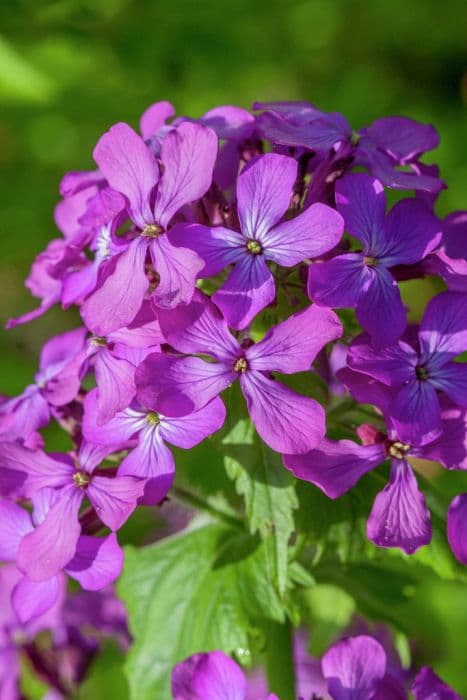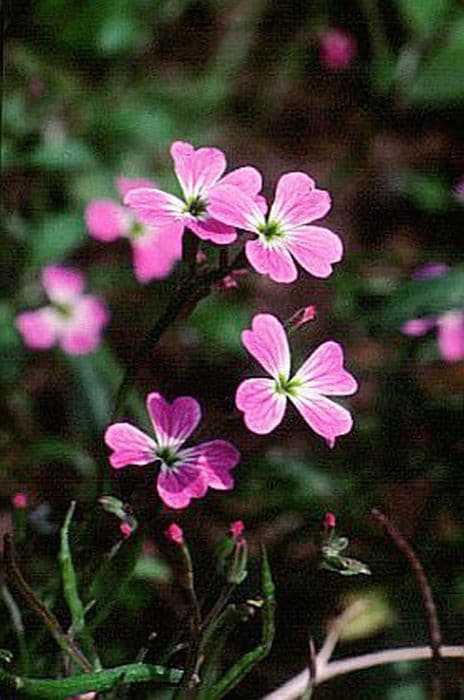Five-leaf Bittercress Cardamine pentaphylla

ABOUT
Cardamine pentaphylla, commonly known as cuckooflower or lady's smock, is a perennial plant that bears a delicate and attractive appearance. It displays a basal rosette of leaves from which emerges a slender stem. The leaves are divided into usually five leaflets arranged palmately, much like the fingers on a hand, with noticeable veins running through their broad, green surfaces. The stems are topped with clusters of small, four-petaled flowers that appear during blooming season. These flowers can be white to pale pink in color and have a simple yet charming look with their cross-shaped formation characteristic of the family they belong to. After flowering, the plant may produce elongated seed pods, which split open to discharge the seeds. The overall impression of the cuckooflower is one of modest elegance and simplicity, making it a delicate addition to any garden space where it can flourish without being overshadowed by larger plants.
About this plant
 Names
NamesFamily
Brassicaceae
Synonyms
Five-leaf Bittercress, Piedmont Bittercress, Cuckoo Flower, Five-leaved Bittercress
Common names
Dentaria pentaphyllos, Cardamine pentaphyllos.
 Toxicity
ToxicityTo humans
Cuckoo flower (Cardamine pentaphylla) is not considered toxic to humans. Therefore, it generally does not cause any symptoms of poisoning or adverse health consequences if ingested in normal food quantities. Always exercise caution and consult with a professional before consuming any wild plants.
To pets
Cuckoo flower is not known to be toxic to pets. It is unlikely to cause any harmful effects if pets consume parts of this plant. However, it's always wise to monitor your pets around plants and discourage them from eating ornamental vegetation as individual animals might have different sensitivities or allergic reactions.
 Characteristics
CharacteristicsLife cycle
Perennials
Foliage type
Deciduous
Color of leaves
Green
Flower color
White
Height
1 foot 4 inches (40 cm)
Spread
1 foot (30 cm)
Plant type
Herb
Hardiness zones
5
Native area
Europe
Benefits
 General Benefits
General Benefits- Ecosystem support: Cardamine pentaphylla, commonly known as cuckoo flower, provides nectar and habitat for a variety of insects including bees and butterflies, supporting local biodiversity.
- Aesthetic value: With its delicate flowers, the cuckoo flower can add beauty to gardens and natural landscapes.
- Soil health: As a part of the flora in its native habitat, it can contribute to the overall health of the soil through natural processes like leaf drop and root decay.
- Edibility: The leaves of Cardamine pentaphylla are edible and can be used in salads, adding a peppery flavor similar to that of watercress.
- Companion planting: It can be used in companion planting to attract beneficial insects that can help control pests.
 Medical Properties
Medical PropertiesThis plant is not used for medical purposes.
 Air-purifying Qualities
Air-purifying QualitiesThis plant is not specifically known for air purifying qualities.
 Other Uses
Other Uses- Cardamine pentaphylla, commonly known as the Cuckoo Flower, has been used in the culinary arts as an edible wild plant, with its leaves adding a peppery flavor to salads.
- The Cuckoo Flower has traditionally been used as a natural fertilizer, as the decomposing plant matter enriches soil with nutrients.
- Garnish for dishes using the delicate white flowers of the Cardamine pentaphylla can add aesthetic appeal to culinary presentations.
- The plant can be used in natural dye production, with different parts yielding varying hues useful for coloring textiles or crafts.
- In some cultures, the Cuckoo Flower is incorporated into folklore and rituals, often symbolizing luck or protection.
- This plant can be used for educational purposes, providing a living example for studies in botany and the life cycle of plants.
- Cardamine pentaphylla may be utilized in landscape design, valued for its early spring blossoms that add beauty to gardens and natural spaces.
- Ecosystem support is another role, as the Cuckoo Flower provides early-season nectar for pollinators like bees and butterflies.
- Some hobbyists may cultivate Cuckoo Flower for bonsai due to its small size and attractive flowers, adapting it to miniature gardens.
- Artists and photographers often use blooms like those of the Cardamine pentaphylla as a subject for their works, inspired by its beauty and delicacy.
Interesting Facts
 Feng Shui
Feng ShuiThe plant Cardamine pentaphylla is not used in Feng Shui practice.
 Zodiac Sign Compitability
Zodiac Sign CompitabilityThe plant Cardamine pentaphylla is not used in astrology practice.
 Plant Symbolism
Plant Symbolism- Rebirth: As a perennial plant that emerges in the spring, Cardamine pentaphylla, commonly known as cuckoo flower, symbolizes rejuvenation and the cycle of life.
- Purity: The cuckoo flower is often considered a symbol of purity due to its delicate and seemingly gentle appearance.
- Adaptability: Since the cuckoo flower can grow in various conditions, including damp areas, it is seen as a symbol of adaptability and resilience.
- New Beginnings: The cuckoo flower is one of the early bloomers, heralding the arrival of spring, thus symbolizing new beginnings and fresh starts.
 Water
WaterCuckoo flower, or Cardamine pentaphyllos, should be watered deeply but infrequently, allowing the soil to dry out slightly between watering to prevent root rot. Typically, this plant will require about one to two gallons of water per week during the active growing season, depending on climate conditions. During the winter months, reduce watering to every other week or less, paying attention to the moisture level of the soil. It's best to water in the morning or evening to reduce evaporation and provide sufficient time for the plant to absorb the moisture.
 Light
LightCuckoo flower thrives best in partial shade, where it can receive dappled sunlight. It should be protected from the harsh afternoon sun, which can cause stress to the plant. An ideal spot would be under a canopy of deciduous trees or on the north or east side of a building where the light is consistent but not overbearing.
 Temperature
TemperatureThe cuckoo flower prefers temperate climates and can tolerate a range from 20°F to 70°F, making it a hardy plant. The ideal temperature for this plant is between 50°F and 65°F. It is not suited for extreme cold and can suffer from frost damage if temperatures drop below 20°F.
 Pruning
PruningPrune cuckoo flower after flowering to maintain a tidy appearance and encourage new growth. Cutting back the spent flowers will also prevent self-seeding if you wish to control its spread. Pruning is best done in late spring or early summer, shortly after the blooming period has ended.
 Cleaning
CleaningAs needed
 Soil
SoilThe best soil mix for Cuckoo Flower (Cardamine pentaphylla) is well-draining, humus-rich soil with a pH between 6.0 and 7.5. A mixture of loam, peat or leaf mold, and perlite or sand can create suitable conditions for its growth.
 Repotting
RepottingCuckoo Flower should be repotted every 2-3 years or when it outgrows its current pot, to refresh the soil and provide space for root expansion.
 Humidity & Misting
Humidity & MistingCuckoo Flower prefers a moderate humidity level, maintaining between 40% to 60% humidity is ideal for this plant.
 Suitable locations
Suitable locationsIndoor
Place in bright, indirect light with moist soil.
Outdoor
Plant in dappled shade with well-draining soil.
Hardiness zone
4-7 USDA
 Life cycle
Life cycleCardamine pentaphylla, commonly known as Five-leaf Bittercress, begins its life cycle as a seed, typically germinating in autumn or early spring when soil temperatures are cool. Upon sprouting, the seedling develops into a rosette of compound leaves with five leaflets, and as it matures, it forms a flowering stalk. The flowers, usually white and four-petalled, bloom in spring and are capable of both self-pollination and cross-pollination through insect visitors. After pollination, the plant produces slender seed pods known as siliques that release seeds once mature. These seeds disperse to begin a new generation, often undergoing a period of dormancy before germinating. During winter or adverse conditions, the plant may die back to its rootstock before resuming growth in the following season.
 Propogation
PropogationPropogation time
Spring to early summer
Cardamine pentaphylla, commonly known as Showy Toothwort, is best propagated by seed. The optimal time for sowing seeds is in the fall, which aligns with the plant's natural seeding time, allowing for a cold stratification period over winter that is necessary for germination. You would collect seeds from mature plants once the seed pods have dried on the plant. Gently harvest the pods and store the seeds in a cool, dry place until ready to plant. When sowing the seeds, place them on top of a well-draining soil medium and lightly press them into the surface, ensuring they are not completely buried. Keep the soil moist but not waterlogged. Germination typically occurs in the spring, after which seedlings can be carefully transplanted to their final growing location.









